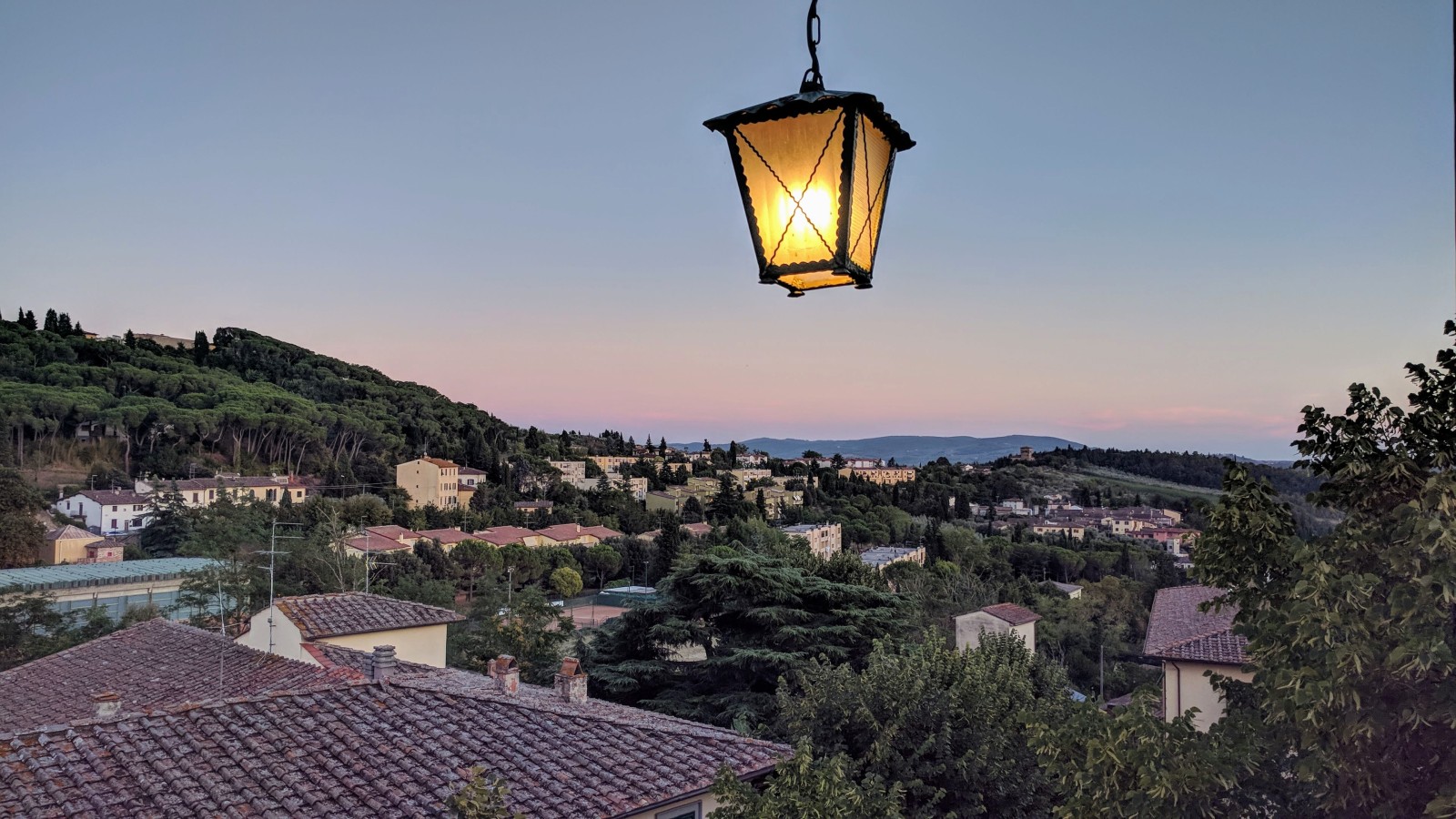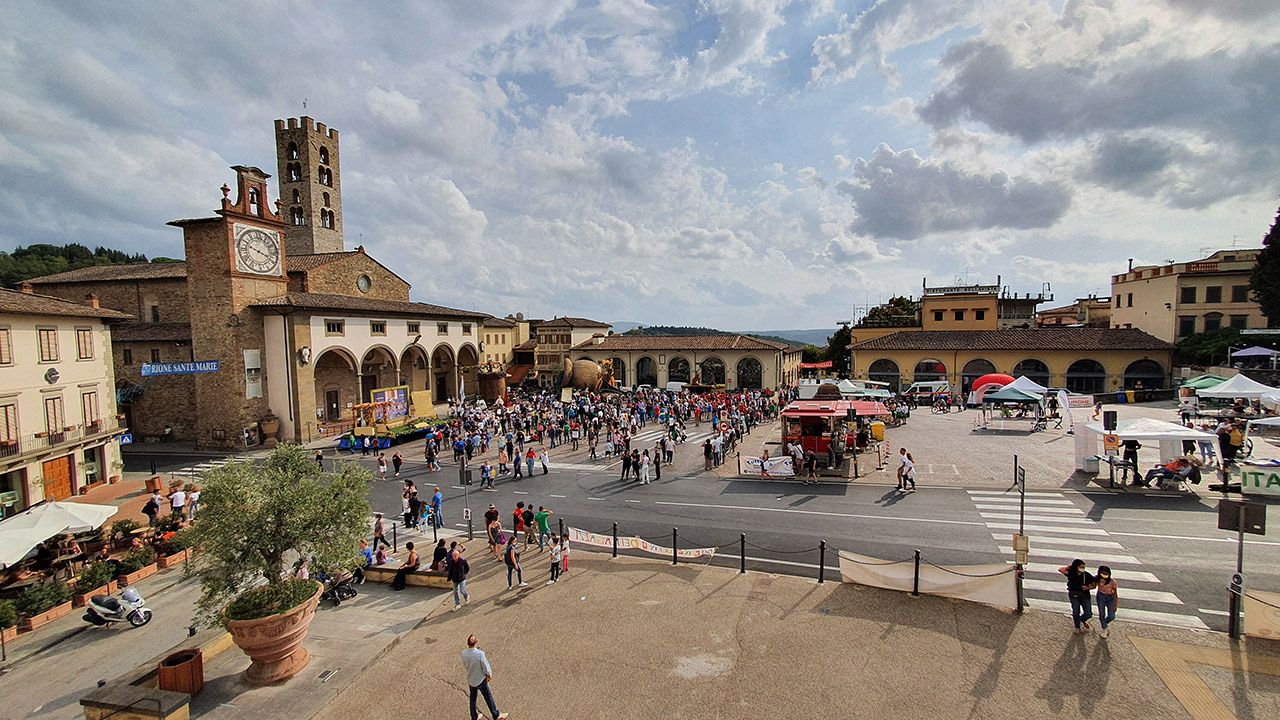



Its traditions date back to the Etruscan era, subsequently the geographical position, the potential of the soil and the relative proximity to Florence favored the birth of a Roman agglomeration.

The Marian sanctuary that is located there is certainly one of the factors that made the municipality known. Also noteworthy is the Buondelmonti square which with its arcades from the end of the sixteenth century hosts the main city festivals. Tourism plays an important part in the economy of the municipality.
"Impruneta is a community of twelve small villages, located in a very short distance from each other, or rather, gathered almost in a heap, on some hills, which arise in that part of the district, or as they call it , Contado Fiorentino, which takes the name of Valdigreve from the river that bathes it; just over six miles from Florence, going towards the sirocco ". Thus wrote Giovan Battista Casotti in his Historical Memoirs of 1714, confirming the idyllic image of a "grouping of small, short-distance villages" set in a frame of pine woods.

Still at the end of the 19th century an attentive observer of the Tuscan reality such as Guido Carocci describes Impruneta as "a large, populated, elegant land" surrounded by "a chain of picturesque hills populated by villages, houses and stately residences".
Traces of Etruscan settlements and archaeological evidence found in Impruneta refer in fact to a remote origin of the town, just as the Roman presence testified by the toponyms indicating the localities of Quintole, Valiano, Fabbiolle is certain. But it was in the Middle Ages that the social and civil role of Impruneta was affirmed, already at the head, after the year 1000, of one of the seventy-two leagues in the Florence countryside.

Equipped with a statute in 1415, it was governed by the Podestà and by a council made up of eleven members; the League, which later became the Potesteria del Galluzzo, was divided in 1536 by an ordinance by Alessandro de 'Medici into four districts: Legnaia, Santa Margherita a Montici, Giogoli and Santa Maria all'Impruneta.
The subsequent transformation of the Potesteria into a Municipality, which led to the separation from both Legnaia and Casellina and Torri, defined 21 peoples in the new Galluzzo community.
Since January 1929 Impruneta has been an autonomous municipality. Impruneta has maintained a strong bond with Florence over time: at first the country residence of noble families such as Gherardini, Ricci, Rossi, Antinori, Corsini, then a holiday resort for many city families, today the town and its countryside are preferred as a permanent residence thanks to the particular geographical position, the ease of communication routes and the optimal climatic conditions.
It is no coincidence that technologically advanced production models and ancient processing methods coexist within individual terracotta companies. In fact, the Civiltà del Cotto is strongly linked to tradition and denotes a close relationship with the surrounding area and with Florence in particular. The roof tiles of Brunelleschi's dome of Santa Maria del Fiore, the building materials of the Medici villas and many noble palaces, the Della Robbia sculptures represent the concrete aspects of the cultural connection between the town and its city.
Moreover, the link with Florence manifested itself from the origins of the village thanks to the cult born with the discovery of the Image of the Madonna and the construction of the church in her honor: the Pieve di Santa Maria, consecrated in 1060 by Cardinal Umberto da Silvacandida . "Our Lady of Impruneta - wrote the historian Franco Cardini - descends into a Florence in crisis to spread over it the mantle of her protector of a great, benevolent, loving but terrible Lady".

The translations, which followed one another over the centuries, strengthened the relationship between a city in crisis due to political-social, natural economic factors - famine, calamities, epidemics - and a local community that found its own unity in the expression of this cult. The Marian cult pushed the mobilization of an entire community under the protection of the Buondelmonti, which, perched in the castle of Montebuoni on the Greve valley, along the road to Rome, exercised dominion over the territory and the protectorate over the Pieve even after its urbanization, following the destruction of the castle by the Florentine army in 1135. The events of the ancient family - also narrated by Dante in the Divine Comedy - recall the well-known historical events that divided the city of Florence into the two factions of the Guelphs and the Ghibellines.
For 5 centuries, through even dramatic events such as the death of Buondelmonte and important events of personalities such as the Pievans Stefano and Andrea, then Archbishop of Florence, the Buondelmonti linked their local political history with that of Florence. If the sources of the time allow us to reconstruct the political history of Impruneta, it is not so for that "crowd made up of shepherds, guardians, merchants" who moved with the cattle in an imposing flow, marked by the rhythm of the seasons. It is however certain that these cattle merchants passed through Impruneta; after all, the territory was at the center of important communication and transhumance routes: in the first place, the high road which, crossing the town, continued to the Valdarno and the Maremma.
The crowds of wayfarers and merchants who stopped in the town over the centuries favored the birth of an important livestock market, which later also became a place for the exchange of other goods, until it took on the appearance of a traditional Fair that is repeated every year. Although its origins are not historically dated, it is believed certain that the Fiera di San Luca, named after the patron saint of the town, can be read both as a moment of commercial exchange and as a phenomenon of religious expression for the numerous pilgrimages linked to the cult of Madonna.
The fame of the Fair grew over time to the point of attracting, from the city and its surroundings, crowds of visitors and no longer just merchants and pilgrims, as evidenced by the well-known seventeenth-century engraving by Jacques Callot and by the numerous paintings by Filippo Napoletano, Brill and many other minor artists. The need to enhance local agricultural products, and wine in particular, favored in more recent times the birth of another folkloric event: the Grape Festival.
In 1926 the owners of the main companies and farms in the town and its surroundings supported the setting up of allegorical floats which, parading through the streets and squares of the town, presented scenes of rural life. Within a political and social climate that tended to celebrate the moments of leisure and work of the masses as an exaltation of the strength and ingenuity of man, the Grape Festival soon assumed importance and notoriety, involving in its realization the whole town, divided into four districts.
The allegorical floats, designed and built by the districts, are still re-proposed today in very original forms and with increasingly modern techniques.
This festival has acquired the aspect of a village festival which, while attracting the attention of Florentine spectators and arousing considerable interest in tourists, remains first and foremost a fulcrum of social aggregation and work and at the same time playful commitment, for the inhabitants of Impruneta.
Impruneta
Address: Piazza Buondelmonti n. 41, 50023
Phone: 055 203641
Site:
www.comune.impruneta.fi.it/Location inserted by
Joele Risaliti